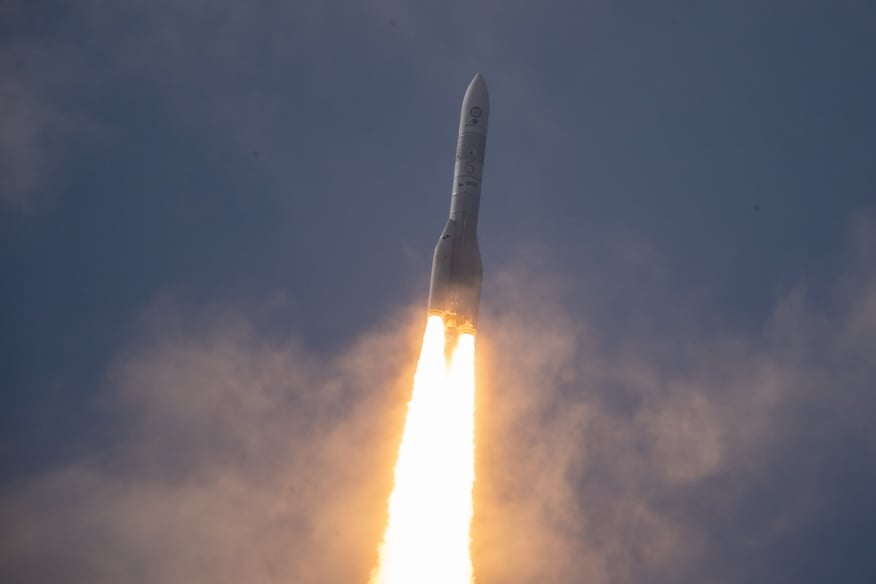European Space Agency launches inaugural Ariane 6 rocket, encounters upper stage issue

NASA Space Technology

Update 7:30 p.m. EDT: An anomaly with the Auxiliary Propulsion Unit on the rocket’s upper stage caused it to deviate from its nominal trajectory and miss both the deployment of two payloads and its deoribt burn. Added information from the Tuesday evening press conference
The inaugural launch of the Ariane 6 rocket, which was lauded from those from the President of France to the NASA Administrator, hit a notable snag in the third and final phase of the mission. Part of the rocket’s upper stage, called the Auxiliary Propulsion Unit (APU), was powered on for a third time as intended, but it quickly shut off after only seconds, causing the upper stage to deviate from its planned trajectory.
During a post-launch press conference, leadership within the European Space Agency (ESA), ArianeGroup (the prime contractor) and CNES (France’s space agency) focused primarily on the successes of the day, rather than the anomaly at the end of the mission.
“This is an historic moment. An inaugural launch of a heavy launcher does not happen every year. It happens probably 20 years or maybe 30 years. The last one was about 30 years ago,” said Josef Aschbacher, the ESA director general, referring to the debut of the Ariane 5, which first launched in 2005. “Today we have launched Ariane 6 successfully and this is a big milestone.”
During the roughly 30-minute, post-launch briefing, no additional details were provided on the APU, which was designed to position the upper stage in a way that would allow it to perform the final burn of its Vinci engine and put it on a deorbit trajectory. The issue with this also meant that the two final payloads, reentry capsules, were unable to be deployed.
The APU was activated twice previously in the mission, but Martin Sion, the CEO of ArianeGroup, the snag on the third attempt is “not understood yet.”
“This is unfortunate, but this is also why we make a tech demo in flight because there are some things that we cannot test on the ground and this is why, from the beginning, we were very clear on the fact that there were two aspects,” Sion said. “One was to demonstrate the launch success, which we did, and then to understand and to gather as much information as possible in this microgravity phase.”
The 62-meter-tall (203-foot-tall) rocket did lift off successfully from Europe’s Spaceport in French Guiana at 3 p.m. EDT (1900 UTC). Stéphane Israël, the CEO of Arianespace, said they don’t see this anomaly as an impediment to launching a military satellite on the second mission targeting launch later this year.
“What we have achieved tonight with the launch success enables us to prepare the next missions, missions, starting with the second one. So we are perfectly on track now to make a second launch this year, in 2024,” Israël said. “So, [the anomaly] has no consequence on the next launches.”
Coming into the launch opportunity on Tuesday, European leaders emphasized the importance of reestablishing an independent method for European countries to send their payloads to space.
“We will keep in mind that this inaugural flight is also the start of a very important phase in the Ariane 6 program,” said Franck Huiban, Head of Civil Program at ArianeGroup, during a pre-launch press briefing on June 25.
The rocket is the culmination of work across 13 European states and more than 600 companies across Europe, with Arianespace as the prime contractor. The launch site is managed by France’s space agency, CNES (Centre National d’Etudes Spatiales).
All you wanted to know about #Ariane6 – animated edition pic.twitter.com/ZSRuJrVNmL
— ESA Space Transport (@ESA_transport) July 5, 2024
Once the rocket enters into operational service, it will be managed by Arianespace, which will manage its commercial use beginning with the second launch. ESA will continue to provide requirements for government missions, like future launches of the Galileo navigation satellites.
The rocket launched in the “Ariane 62” configuration, meaning it lifted off with two solid rocket boosters, which each provide 3500 kN (~787,000 lbs.) of thrust. The two-stage rocket uses a combination of liquid hydrogen and liquid oxygen on both stages, similar to NASA’s Space Launch System rocket.
At the base of the first stage is the Vulcain 2.1 engine, a successor to the Vulcain engine used on the Ariane 5 rocket. A single Vinci engine powers the upper stage of the Ariane 6, which can nominally burn for up to 900 seconds, producing 180 kN (40,500 lbs.) of thrust.
At liftoff, the Ariane 62 weighs about 540 t (1.2 million lbs.) The Ariane 62 that launched on this inaugural mission used 20-meter-long (66-foot-long) payload fairings.

What’s on board?
The first launch of an Ariane 6 rocket acted as a rideshare mission for a collection of companies, agencies and researchers. There are four deployers on board the rocket. Among the payloads are nine satellites and two reentry capsules that will be deployed.
However, those two reentry capsules will not be recovered, according to Michel Bonnet, ESA’s inaugural flight principal. That’s because they’re targeting splashdown in an area of the Pacific Ocean called “Point Nemo,” which is the farthest from land.
“It would have been quite costly an activity to try to recover them,” Bonnet explained. “So, for this flight, none of them will be recovered.”

There were also five fixed payloads that were designed to remain attached to the Ariane 6 upper stage, including YPSat (Young Professionals Satellite), which was designed to record video to document the 180-minute-long mission.
YPSat also serves as platform to host payloads like OscarQube, which will measure the Earth’s magnetic field during the launch ascent, and AMSAT, an antenna that supports ham radio communication.
“The first flight of a new rocket is always an astounding moment as there are hundreds of thousands of details that have to work in perfect harmony – for the first time together in full,” said Loïc Bourillet, head of ESA’s Collective Launch Service Procurement, in a statement.

NASA’s payload hitching a ride on this inaugural flight was the CURIE satellite. The CUbesat Radio Interferometry Experiment is designed to “measure radio waves coming from the Sun and other radio sources in the sky.”
CURIE is actually a pair of connected spacecraft that will separate from one another once on orbit. This will also NASA researchers to gather radio waves from two locations simultaneously, which will allow them to detect the origins of any detected radio waves through a technique called “interferometric analysis.”
These satellites, a first of their kind, will serve as a pathfinder for developing other space-based radio observatories. Part of their mission will be using interferometry “to study radio burst emissions from solar eruptions, such as flares and coronal mass ejections in the inner heliosphere.”
“When a spot on the first flight of Ariane 6 was made available to us, the CURIE team was very excited. It is such a big event in the world of rocketry and space exploration,” said David Sundkvist, principal investigator for the mission, in a statement. “For a team that is developing a new concept – a formation flying satellite radio interferometer – launching on the inaugural flight of Europe’s new rocket is like a satellite developer’s dream come true.”

Impact of launch delays
The planned launch of the Ariane 6 rocket comes nearly four years late from its original planned debut. In January 2017, ESA said the first launch of the Ariane 6 would take place in 2020, but a faced challenges, like development issues with both the first and second stage engines.
“Like in every major development, we have faced problems and we’ve had a number of delays for a number of reasons we have explained along the way, be it because we moved technological choices because we had a capability in industry that had not faced a major development ever since the beginning of the Ariane 5,” said Lucia Linares, the head of space transportation strategy and institutional launches for ESA, during a pre-launch press briefing.
7️⃣ Countdown to liftoff!
7 days to #Ariane6 launch.
7 seconds before liftoff the Vulcain 2.1 engine roars to life. ????Only when the boosters are ignited will the Ariane 6 rocket start to move of the launchpad. ???? pic.twitter.com/S1ZaCvgNZU— ESA Space Transport (@ESA_transport) July 2, 2024
She also pointed to the loss of the Russian Soyuz rocket as a pain point for Europe, since it couldn’t rely on that launch vehicle to pick up some of the slack between the final flight of the Ariane 5 rocket on July 5, 2023, and the debut of the Ariane 6.
Huiban added that during the course of development, they determined that the rocket needed more capabilities than were available as part of its original design.
“We have made a lot of innovations between Ariane 6 and Ariane 5. Innovation in particular on the upper stage of the launcher with two, brand new propulsion systems: the re-ignitable Vinci engine and also an auxiliary power unit,” Huiban said. “This gives Ariane 6 much broader mission capability compared to the Ariane 5, but of course, since we introduced an innovative system, we met some difficulties.”

Once the rocket is certified, Arianespace plans to launch the vehicle between nine and 12 times per year on average. They plan to launch the second flight later in 2024. In 2025, there are six Ariane 6 launches planned, followed by eight in 2027.
Officials noted that they already built up a launch backlog of about 30 missions, 18 of which will be dedicated to launching Amazon’s Project Kuiper internet satellites.
Ariane 6 enters into a launch landscape currently dominated by SpaceX, which launched 67 times so far in 2024 with its Falcon 9 rocket and once with its Falcon Heavy. It also faces competition from the likes of newer launch vehicles, like United Launch Alliance’s (ULA) Vulcan rocket, which aims to launch up to 25 times annually, and the forthcoming New Glenn rocket from billionaire Jeff Bezos’ Blue Origin.
When asked how the Ariane 6’s launch cadence will allow it to remain competitive in such a commercial marketplace, Linares said the core focus of the Ariane 6 is “to serve European institutional missions.”
“This is the core reason why the public sector is funding this launcher and why we have a guaranteed access to space. So first and foremost is the guarantee of access to space for our missions and those are the missions of the European Space Agency, of the European Union, of EUMETSAT and of all member states,” Linares said.
“This is the core mission of this launcher. And then of course, to offset those costs for the public sector, the launcher is also operated and serving commercial clients under the responsibility of various paths for both institutional and commercial clients.”
However, despite the confidence of ESA and Arianespace of the rocket’s abi lity to compete in a marketplace they are already seeing some hurdles.
In late June, the aforementioned EUMETSAT (European Organization for the Exportation of Meteorological Satellites) announced that the launch of its Meteosat MTG-S1 satellite was being moved from the third launch of the Ariane 6 (the first to employ the Ariane 64 configuration) to SpaceX’s Falcon 9 rocket. This was first reported by the outlet, The world.

In response, Philippe Baptiste, the chairman and CEO of CNES wrote on LinkedIn that the decision was “quite a brutal change as the flight was supposed to take place very soon,” adding that “today is a very disappointing day for European space efforts.”
“The technical conditions were met for a launch on Ariane 6 and the launcher was indeed available. I am impatiently waiting to understand what reasons could have led Eumetsat to such a decision, at a time where all major European space countries as well as the European Commission are calling for launching european satellites on European launchers!” Baptiste wrote. “Not mentioning the fact that we are 10 days away from the maiden flight of Ariane 6.”
Josef Aschbacher, the director general of ESA, also expressed his disappointment on X (formerly Twitter), stating that the decision from EUMETSAT was “difficult to understand.”
“Plans still target one more launch in 2024 and the ramp-up of Ariane 6 has not changed, except now for the loss of MTG-S1,” Aschbacher wrote. “The end of the launcher crisis is within reach. Now is the time for Europe to support autonomous access to space, which is on the horizon.”
Given its multiple launch sites in Florida and California, SpaceX’s Falcon 9 has been called upon multiple times to help fill the gap left by the lack of launchers in Europe. Most recently, Falcon 9 rockets were used to launch the joint ESA and Japanese Aerospace Exploration Agency (JAXA) EarthCARE (Earth Cloud Aerosol and Radiation Explorer) satellite and a pair of Galileo satellites.
Assuming a successful debut launch on July 9, the plan is for the second Ariane 6 launch, which will also be the first commercial launch, to take place in December 2024.
Discover more from Tamfis Nigeria Lmited
Subscribe to get the latest posts sent to your email.



 Hot Deals
Hot Deals Shopfinish
Shopfinish Shop
Shop Appliances
Appliances Babies & Kids
Babies & Kids Best Selling
Best Selling Books
Books Consumer Electronics
Consumer Electronics Furniture
Furniture Home & Kitchen
Home & Kitchen Jewelry
Jewelry Luxury & Beauty
Luxury & Beauty Shoes
Shoes Training & Certifications
Training & Certifications Wears & Clothings
Wears & Clothings
















